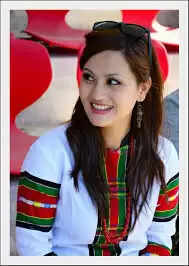Traditional Dress of Mizoram Men and Women
Jul 4, 2025, 01:09 IST

The northeastern state of Mizoram is culturally diverse, and its clothing emanates the simplicity, beauty, and vibrancy of the people. In Mizoram, clothing is influenced by tribal traditions and seasons, which affects both men's and women's apparel.

Typical Clothing of Mizo Women
Mizo women wear a traditional wrap-around cloth called Puan. Puan is a colorful hand-woven fabric that has significance to the people of the state. The garment, which is the most recognizable and colorful, is called Puanchei, which is usually saved for festivals like Chapchar Kut or Pawl Kut. Most varieties of Puanchei are made of cotton fabric, which stores the heat as the day cools down. Puanchei are generally made with a checkered pattern of black and white, with borders of red or multicolor, with a blouse/tunic (Kawrechi) to match the pattern of the garment, or that have no pattern submitted other than a handwoven or embroidered design.
Many of the younger women generally wear a more modern version of Puan made of lightweight fabrics, but with many traditional designs. The nature and colors of the Puans may indicate social or marital status in some communities.
Traditional Attire of Mizo Men
The traditional dress for Mizo men is simpler but equally meaningful. A common garment is the Puan, similar to the women’s version, though usually darker and less ornate. It is worn like a sarong or wrapped around the waist. Men also wear a white cotton shirt or tunic, especially during festivals or formal gatherings.
Mizo men often employ a "Chaddar" or shawl made of wool or a thick enough cotton to stay warm when it’s cold. It is functional but also a form of decoration when performing cultural dances or in a performance.
In tribal festivities or dance events like the Cheraw Dance, men may also wear headgear or accessories made from bamboo and feathers to enhance the traditional look.
Preservation of Heritage
Even if modern and casual clothing has become the norm of everyday life in contemporary society, the people of Mizoram still regard their traditional dress to be a source of pride. The state government and local craftsmen are working diligently to ensure the festive, wedding, and cultural events have a supply of handloom weavings, contributing to the preservation of the spirit of Mizo tradition.

Typical Clothing of Mizo Women
Mizo women wear a traditional wrap-around cloth called Puan. Puan is a colorful hand-woven fabric that has significance to the people of the state. The garment, which is the most recognizable and colorful, is called Puanchei, which is usually saved for festivals like Chapchar Kut or Pawl Kut. Most varieties of Puanchei are made of cotton fabric, which stores the heat as the day cools down. Puanchei are generally made with a checkered pattern of black and white, with borders of red or multicolor, with a blouse/tunic (Kawrechi) to match the pattern of the garment, or that have no pattern submitted other than a handwoven or embroidered design.
Many of the younger women generally wear a more modern version of Puan made of lightweight fabrics, but with many traditional designs. The nature and colors of the Puans may indicate social or marital status in some communities.
Traditional Attire of Mizo Men
The traditional dress for Mizo men is simpler but equally meaningful. A common garment is the Puan, similar to the women’s version, though usually darker and less ornate. It is worn like a sarong or wrapped around the waist. Men also wear a white cotton shirt or tunic, especially during festivals or formal gatherings.
Mizo men often employ a "Chaddar" or shawl made of wool or a thick enough cotton to stay warm when it’s cold. It is functional but also a form of decoration when performing cultural dances or in a performance.
In tribal festivities or dance events like the Cheraw Dance, men may also wear headgear or accessories made from bamboo and feathers to enhance the traditional look.
Preservation of Heritage
Even if modern and casual clothing has become the norm of everyday life in contemporary society, the people of Mizoram still regard their traditional dress to be a source of pride. The state government and local craftsmen are working diligently to ensure the festive, wedding, and cultural events have a supply of handloom weavings, contributing to the preservation of the spirit of Mizo tradition.



